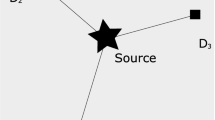Abstract
High-speed algorithms for detecting and localizing randomly distributed pulse point objects capable of generating instantaneous delta pulses at random time instances. The search is carried out using the reception device (detector), which can freely move within the search interval and dynamically adjust the size of the scanning window. In this work the a priori information about the distribution of the sought signal source is limited by the single-mode functions with a stepwise probability density function, which provides that the algorithms are physically implementable. The parameters of the optimal search are computed in dependence on the a priori probability density function of the sought signal source and the required localization accuracy.

Similar content being viewed by others
REFERENCES
H. Poor, An Introduction to Signal Detection and Estimation (Springer-Verlag, New York, 1985).
C. Szegedy, A. Toshev, and D. Erhan, ‘‘Deep neural networks for object detection,’’ Adv. Neural Inf. Process. Syst. 26, 1–8 (2013).
G. Cao, X. Xie, W. Yang, et al., ‘‘Feature-fused SSD: Fast detection for small objects,’’ Proc. SPIE 10615, 106151E. https://doi.org/10.1117/12.2304811
C. Grupen and I. Buvat, Handbook of Particle Detection and Imaging (Springer, Berlin, 2011). https://doi.org/10.1007/978-3-642-13271-1
I. A. Birger, Technical Diagnostics (Mashinostroenie, Moscow, 1978).
C. E. Shannon, ‘‘A mathematical theory of communication,’’ Bell Syst. Tech. J. 27, 379–423 (1948). https://doi.org/10.1002/j.1538-7305.1948.tb01338.x
B. V. Gniedenko, J. K. Bielajew, and A. D. Sołowiew, Mathematical Methods in Theory of Reliability (Nauka, Moscow, 1965; WNT, Warszawa, 1968).
X. Zhu, L. Wen, G. Hobbs, Y. Zhang, Y. Wang, D. R. Madison, R. N. Manchester, M. Kerr, P. A. Rosado, and J.-B. Wang, ‘‘Detection and localization of single-source gravitational waves with pulsar timing arrays,’’ Mon. Not. R. Astron. Soc. 449, 1650–1663 (2015). https://doi.org/10.1093/mnras/stv381
S. Weinberg, Cosmology (Oxford Univ. Press, New York, 2008).
V. S. Kirichuk, K. Yu. Mokin, and A. L. Reznik, ‘‘Algorithms for processing of a series of digital aerospace images based on automatic search for the conjugate points,’’ Patern Recognit. Image Anal. 11, 192–194 (2001).
G. I. Gromilin, V. P. Kosykh, S. A. Popov, and V. A. Streltsov, ‘‘Suppression of the background with drastic brightness jumps in a sequence of images of dynamic small-size objects,’’ Optoelectron., Instrum. Data Process. 55, 213–221 (2019) https://doi.org/10.3103/S8756699019030014
V. K. Klochko, ‘‘Detection of moving objects by a passive scanning system,’’ Optoelectron., Instrum. Data Process. 55, 59–65 (2019). https://doi.org/10.3103/S8756699019010102
A. L. Reznik, V. M. Efimov, A. A. Solov’ev, and A. V. Torgov, ‘‘Errorless readout of random discrete-point fields,’’ Optoelectron., Instrum. Data Process. 48, 506–514 (2012). https://doi.org/10.3103/S8756699012050111
A. L. Reznik, A. V. Tuzikov, A. A. Soloview, and A. V. Torgov, ‘‘Time-optimal algorithms of searching for pulsed-point sources for systems with several detectors,’’ Optoelectron., Instrum. Data Process. 53, 203–209 (2017). https://doi.org/10.3103/S8756699017030013
A. L. Reznik, A. V. Tuzikov, A. A. Soloviev, A. V. Torgov, and V. A. Kovalev, ‘‘Time-optimal algorithms focused on the search for random pulsed-point sources,’’ Comput. Opt. 43, 605–610 (2019). https://doi.org/10.18287/2412-6179-2019-43-4-605-610
Funding
The work is carried out under partial support of the Russian Foundation for Basic Research (project no. 19-01-00128) and of the Ministry of Science and Higher Education of the Russian Federation (state registration no. AAA-A17-117052410034-6).
Author information
Authors and Affiliations
Corresponding authors
Additional information
Translated by E. Oborin
About this article
Cite this article
Reznik, A.L., Solov’ev, A.A. & Torgov, A.V. Localization of Random Pulse Point Sources Using Physically Implementable Search Algorithms. Optoelectron.Instrument.Proc. 56, 598–607 (2020). https://doi.org/10.3103/S8756699020060114
Received:
Revised:
Accepted:
Published:
Issue Date:
DOI: https://doi.org/10.3103/S8756699020060114



